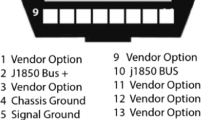Abstract
Location information is very important for many applications of vehicular networks such as routing, network management, data dissemination protocols, road congestion, etc. If some reliable prediction is done on vehicle’s next move, then resources can be allocated optimally as the vehicle moves around. This would increase the performance of VANETs. A Kalman filter is employed for predicting the vehicle’s future location in this paper. We conducted experiments using both real vehicle mobility traces and model-driven traces. We quantitatively compare the prediction performance of a Kalman filter and neural network-based methods. In all traces, the proposed model exhibits superior prediction accuracy than the other prediction schemes.







Similar content being viewed by others
References
Toor, Y., Muhlethaler, P., Laouiti, A., & Fortelle, A. (2008). Vehicular ad hoc networks: Applications and related technical issues. IEEE Communications Surveys and Tutorials, 10(3), 74–88.
Boukerche, A., Oliveira, H., Nakamura, E., & Loureiro, A. (2008). Vehicular ad hoc networks: A new challenge for localization-based systems. Computer Communications, 31(12), 2838–2849.
Priggouris, I., Zervas, E., & Hadjiefthymiades, S. (2006). Location based network resource management. In I. K. Ibrahim (Ed.), Handbook of research on mobile multimedia. PA: Idea Group Inc.
Hadjiefthymiades, S., & Merakos, L. (1999). ESW4: Enhanced scheme for WWW computing in wireless communication environments. ACM SIGCOMM Computer Communication Review, 29(5), 24–35.
Karmouch, A., & Samaan, N. (2005). A mobility prediction architecture based on contextual knowledge and spatial conceptual maps. IEEE Transaction on Mobile Computing, 4(6), 537–551.
Nhan, V. T. H., & Ryu, K. H. (2006). Future location prediction of moving objects based on movement rules. Springer ICIC, LNCIS, 344, 875–881.
Xiao, Y., Zhang, H., & Wang, H. (2007). Location prediction for tracking moving objects based on grey theory. In Proceedings of fourth international conference on IEEE fuzzy systems and knowledge discovery, Aug., pp. 390–394.
Xu, L., Mitton, N., & Simplot, Ryl D. (2011). Mobility prediction based neighborhood discovery in mobile ad hoc networks. Networking, 1, 241–253.
Capka, J., & Boutaba, R. (2004). Mobility prediction in wireless networks using neural networks. In Proceedings of the IFIP/IEEE international conference on the management of multimedia networks and services, October, pp. 320–334.
Fulop, P., Imre, S., Szabo, S., & Szalka, T. (2009). The accuracy of location prediction algorithms based on markovian mobility models. International Journal of Mobile Computing and Multimedia Communications, 1(2), 1–21.
Kaaniche, H., & Kamoun, F. (2010). Mobility prediction in wireless ad hoc networks using neural networks. Journal of Telecommunications, 2(1), 95–101.
Anagnostopoulos, T., Anagnostopoulos, C., & Hadjiefthymiades, S. (2009). An online adaptive model for location prediction. In Proceedings of the 3rd international ICST conference on autonomic computing and communication systems, Cyprus, pp. 64–78.
Anagnostopoulos, T., Anagnostopoulos, C., & Hadjiefthymiades, S. (2011). An adaptive location prediction model based on fuzzy control. Computer Communications, 34, 816–834.
Kalman, R. E. (1960). A new approach to linear filtering and prediction problems. Transactions of the ASME Journal of Basic Engineering (Series D), 82, 35–45.
Yang, S. K., & Liu, T. S. (1999). State estimation for predictive maintenance using Kalman filter. Reliability Engineering and System Safety, 66, 29–39.
Bavdekar, V. A., Deshpande, A. P., & Patwardhan, S. C. (2011). Identification of process and measurement noise covariance for state and parameter estimation using extended Kalman filter. Journal of Process Control, 21(4), 585–601.
Mehra, R. K. (1970). On the identification of variances and adaptive Kalman filtering. IEEE Transactions on Automatic Control, AC–15, 175–184.
Ding, W. D., Wang, J. L., Rizos, C., & Kinlyside, D. (2007). Improving adaptive Kalman estimation in GPS/INS integration. Journal of Navigation, 60, 517–529.
Mohamed, A. H., & Schwarz, K. P. (1999). Adaptive Kalman filtering for INS/GPS. Journal of Geodesy, 73, 193–203.
Yim, J., Joo, J., & Park, C. (2011). A Kalman filter updating method for the indoor moving object database. Expert Systems with Applications, 38, 15075–15083.
Karmouch, A., & Samaan, N. (2005). A mobility prediction architecture based on contextual knowledge and spatial conceptual maps. IEEE Transaction on Mobile Computing, 4(6), 537–551.
Hadjiefthymiades, S., & Merakos, L. (2003). Proxies+ path prediction: Improving web service provision in wireless-mobile communications. ACM/Kluwer Mobile Networks and Applications Journal (MONET), Special Issue on Mobile and Wireless Data Management, 8(4), 389–399.
Zhu, H., Chang, S., Li, M., Naik, S., & Shen, X. (2011). Exploiting temporal dependency for opportunistic forwarding in urban vehicular networks. In Proceedings of IEEE INFOCOM, Shanghai, China, April, pp. 2192–2200.
Deakin, R. E., Hunter, M. N., & Karney, C. F. F. (2010). The Gauss-Krger projection. In Proceedings of the 23rd Victorian regional survey conference, Warrnambool, September. http://user.gs.rmit.edu.au/rod/files/publications/Gauss-Krueger.
Wu, H., Palekar, M., Fujimoto, R. M., Guensler, R., Hunter, M., Lee, J., et al. (2005). An empirical study of short range communications for vehicles. In Proceedings of the ACM workshop on vehicular ad hoc networks, September, pp. 83–84.
Bai, F., Sadagopan, N., & Helmy, A. (2003). IMPORTANT: A framework to systematically analyze the impact of mobility on performance of routing protocols for ad hoc networks. In Proceedings of IEEE INFOCOM, April, pp. 825–835.
Cadger, F., Curran, K., Santos, J., & Moffett, S. (2011). An analysis of the effects of intelligent location prediction algorithms on greedy geographic routing in mobile ad-hoc networks. In Proceedings of artificial intelligence and cognitive science, Derry, Northern Ireland.
Mousavi, S. M., Rabiee, H. R., Moshref, M., & Dabirmoghaddam, A. (2007). MobiSim: A framework for simulation of mobility models in mobile ad-hoc networks. In Proceedings of third IEEE international conference on wireless and mobile computing, networking and communications, White Plains, NY, USA, pp. 0–82.
Istook, E., & Martinez, T. (2002). Improved back-propagation learning in neural networks with windowed momentum. International Journal of Neural Systems, 12(3–4), 303–318.
Feng, H. F., & Ma, M. D. (2010). Traffic prediction over wireless networks. In T. Lagkas, P. Angelidis, & L. Georgiadis (Eds.), Wireless network traffic and quality of service support: Trends and standards (pp. 87–112). NJ: IGI Global Publisher.
Haykin, S. (1999). Neural networks. Upper Saddle River, NJ: Prentice Hall.
Shareef, A., Zhu, Y., Musavi, M., & Shen, B. (2007). Comparison of MLP neural networks and Kalman filter for localization in wireless sensor network. In Proceedings of 19th IASTED international conference on parallel and distributed computing systems, Cambridge, MA, USA.
Acknowledgments
This work was supported in part by the NSFC under Grant Nos. 61363081 and 61072063, the NSF of Gansu Province under Grant No. 1308RJZA294, the Fundamental Research Funds for the Gansu Universities and NWNU-LKQN-11-4.
Author information
Authors and Affiliations
Corresponding author
Rights and permissions
About this article
Cite this article
Feng, H., Liu, C., Shu, Y. et al. Location Prediction of Vehicles in VANETs Using A Kalman Filter. Wireless Pers Commun 80, 543–559 (2015). https://doi.org/10.1007/s11277-014-2025-3
Published:
Issue Date:
DOI: https://doi.org/10.1007/s11277-014-2025-3




